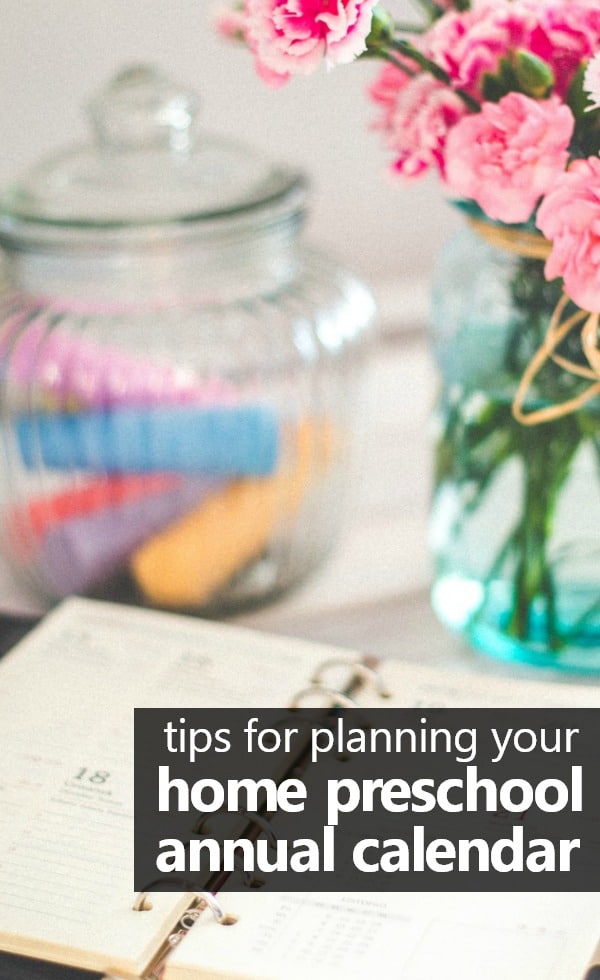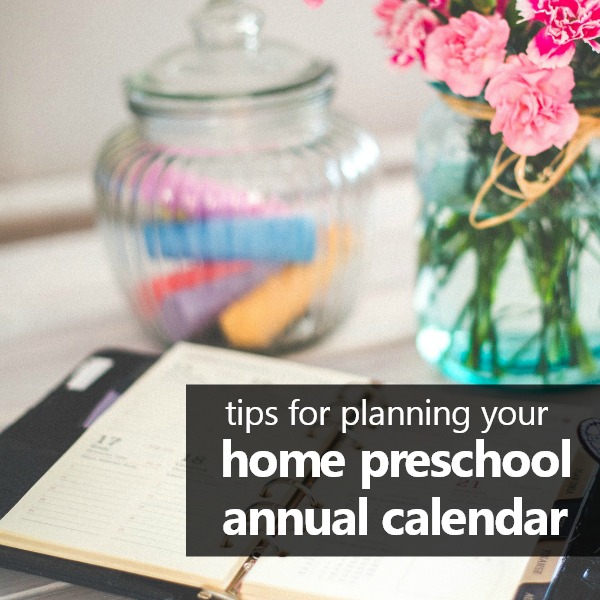So far in the how to teach home preschool series we’ve explored teaching and learning styles in Unit 1. Then in Unit 2 you learned more about the preschool skills you’ll be teaching and the kinds of activities you can use to teach them, now we’re going to take a look at when you’ll be teaching. First we’ll examine some long-term scheduling options and help you develop a home preschool annual calendar.
Personally I am a big picture person. I need to see where we are going before I get to the finer details. For that reason I prefer to develop a long-term plan for home preschool. However, if you are not quite as Type A as me you can do this in a more informal sense or just skip it all together. Remember that developing a home preschool routine that works for you and your family is the ultimate goal.

Uses of a Long-Term Plan
In addition to generally helping with organization, I find that having a long-term plan:
- Helps plan home preschool with family events, vacations, and special activities in mind
- Helps to plan seasonal activities, field trips, and themes
- Helps to pace specific goals for each child
Developing Your Long-Term Plan
Step 1: Choose your annual calendar model.
There are many different calendar options. Below is a list of some of the more popular ones chosen by families.
- School Calendar-Families that choose to follow a school calendar follow the calendar by their local school system. This can be very useful if you have older kids in school.
- Year-Round-Families that choose to follow this calendar do home preschool activities throughout the year. They may incorporate planned breaks occasionally, but for the most part the home preschool routine continues as normal. This can be a great method for kids who really thrive on routine and a predictable schedule. It also nurtures the idea that learning goes on all the time.
- 3 Weeks On, 1 Week Off-This can be a wonderful hybrid schedule for families that like the structure of an ongoing home preschool routine, but also enjoy a little more flexibility or more frequent breaks.
When I teach home preschool, I tend to prefer a 3 weeks on, 1 week off schedule. This allows me to plan a 3 week unit on a preschool theme of interest to the kids. Then we take one week off for more open-ended free play and exploring. During the off week, we still do some of our home preschool daily routines, but there are fewer adult-directed activities and more child-led play. I also use that off week to prepare materials for the next three-week theme. This wiggle room also comes in handy if anyone gets sick or we want to extend a specific unit a little bit longer.
When considering what calendar is best for your family, think about any other family obligations you have and how you and your child will work best.
Task 1: Grab the free printable long-term planning resource. Select the long-term model you want to try, or develop your own.
Step 2: Map out your annual calendar.
Once you’ve decided which model you’ll be following it’s time to get started with your annual calendar. You can be as detailed or as general as you would like with this. Below are some things you might do to plan your annual calendar:
- Identify dates for home preschool based on the model you selected in Step 1 above.
- Write in any special dates: holidays, family trips, visits from relatives, local events/festivals you like to attend and might want to incorporate into your home preschool studies, etc
- Brainstorm any themes or key concepts you want to teach and add them to the calendar
Task 2: Use the free printable Long-Term Plan resources and tips above to sketch some dates for your first year of home preschool. Remember this is just a draft. You will use this throughout your home preschool planning and modify it as needed. Add this to a home preschool planning binder where you can store all of your planning materials.
Step 3: Add Child’s Goals to the Annual Calendar
I also find it helpful to pencil in some of the goals we will be working on for each child. This helps serve as a reminder to incorporate these skills into our plans, and it is a helpful way to keep us on pace for introducing all of the skills we plan to cover during the year.
Task 3: Use the Long-Term Plan you’ve been working on and the skills you identified for each child in Unit 2. Match some specific skills for each child with your annual calendar.
This is Unit 3, Lesson 1 of the Guide to Getting Started with Home Preschool. Return to the main How to Teach Preschool at Home page or proceed to Unit 3, Lesson 2: Determine Extracurricular Activities.

Leave a Reply